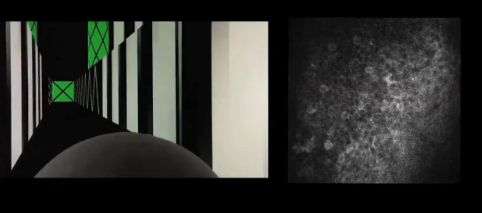Why do we remember some things and not others? In a unique imaging study, two Northwestern University researchers have discovered how neurons in the brain might allow some experiences to be remembered while others are forgotten. It turns out, if you want to remember something about your environment, you better involve your dendrites.
Using a high-resolution, one-of-a-kind microscope, Daniel A. Dombeck and Mark E. J. Sheffield peered into the brain of a living animal and saw exactly what was happening in individual neurons called place cells as the animal navigated a virtual reality maze.
The scientists found that, contrary to current thought, the activity of a neuron's cell body and its dendrites can be different. They observed that when cell bodies were activated but the dendrites were not activated during an animal's experience, a lasting memory of that experience was not formed by the neurons. This suggests that the cell body seems to represent ongoing experience, while dendrites, the treelike branches of a neuron, help to store that experience as a memory.
"There are a lot of theories on memory but very little data as to how individual neurons actually store information in a behaving animal," said Dombeck, assistant professor of neurobiology in the Weinberg College of Arts and Sciences and the study's senior author. "Now we have uncovered signals in dendrites that we think are very important for learning and memory. Our findings could explain why some experiences are remembered and others are forgotten."
In the brain's hippocampus, there are hundreds of thousands of place cells—neurons essential to the brain's GPS system. Dombeck and Sheffield are the first to image the activity of individual dendrites in place cells.
Their findings contribute to our understanding of how the brain represents the world around it and also point to dendrites as a new potential target for therapeutics to combat memory deficits and debilitating diseases, such as Alzheimer's disease (AD). Disruption to the brain's GPS system is one of the first symptoms of AD, with many patients unable to find their way home. Understanding how place cells and their dendrites store these types of memories could help us find new ways to treat the disease.
In a study published in Nature, Northwestern researchers have discovered how neurons in the brain might allow some experiences to be remembered while others are forgotten. The two movies illustrate two of the study's techniques. The left movie shows movement through a virtual maze that is controlled by an animal running on a trackball. (The ball is visible at the bottom.) The right movie shows neural activity measured with a cutting-edge imaging technique; each lit-up, doughnut-shaped structure is a neuron firing action potentials. The activity of these neurons represents the animal's experience of where they are in the environment. Whether the neurons store this experience depends on the activity of their dendrites (the branched extensions emanating from the neuron's cell body, along which impulses are received from other cells). Note: The movies are not time synchronized and are presented for illustration purposes only. Credit: Credit: Northwestern University
The Northwestern study will be published Oct. 26 by the journal Nature.
Neuroscientist John O'Keefe discovered place cells in 1971 (and received this year's Nobel Prize in physiology and medicine), but it is only in the last few years that scientists, such as Dombeck and Sheffield, have been able to image these neurons that represent a map of where we are in our environment.
In their study, Dombeck and Sheffield found dendrite signals that could explain how an animal can experience something without storing the experience as a memory.
They saw that dendrites are not always activated when the cell body is activated in a neuron. Signals produced in the dendrites (used to store information) and signals within the neuron cell body (used to compute and transmit information) can be either highly synchronized or desynchronized depending on how well the neurons remember different features of the maze.
Scientists have long believed that the neuronal tasks of computing and storing information are connected—when neurons compute information, they are also storing it, and vice versa. The Northwestern study provides evidence against this classic view of neuronal function.
"We experience events all the time, which must be represented in the brain by the activity of neurons, but not all these events can be recalled later," said Mark E. J. Sheffield, a postdoctoral fellow in Dombeck's lab and first author of the study.
"A daily commute to work, for example, requires the activity of millions of neurons, but you would be hard pressed to remember what was happening halfway through your commute last Tuesday," Sheffield said. "How is it then that the neurons could be activated during the commute without storing that information in the brain? Now we may have an explanation for how this occurs."
Dombeck and Sheffield built their own laser scanning microscope that can image neurons on multiple planes. They then studied individual animals navigating (on a trackball) a virtual reality maze constructed using the video game Quake II.
Each lit-up structure seen in the images they took indicate a neuron firing action potentials. The activity of these neurons represents an animal's experience of where it is in the environment, the researchers said. Whether the neurons store this experience or not appears to depend on the activity of the neurons' dendrites.
More information: "Calcium transient prevalence across the dendritic arbor predicts place field properties," Nature, 2014. DOI: 10.1038/nature13871
Journal information: Nature
Provided by Northwestern University























